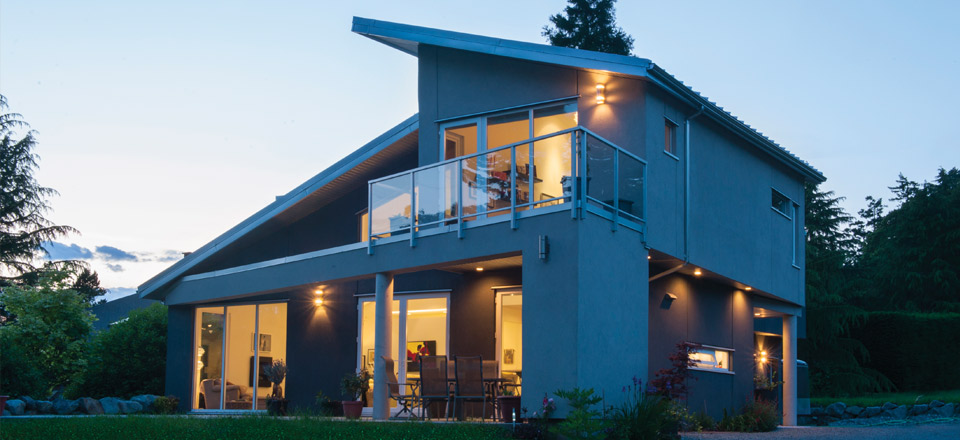– Story by Barry Mathias, Photography by nuttycake.com –
For most of us, the acquisition of a home is the biggest investment of our lives. We may buy an established home and make changes, or use professionals to help us design a new house; but a few, like Silvia Bonet, have the architectural skills to design and create their own, individual living space.
Silvia is a partner at Finlayson Bonet Architecture, and her new house is both exciting and decidedly different. Set in the tranquil environs of Deep Cove, the building has a modern, challenging appearance: a complex interaction of contrasting light and dark grey exterior walls, light grey aluminum roof trim, and an abundance of large windows. From the road, I am conscious of angled roofs, a balcony with a glass railing set above a powerful concrete beam that stretches across the front of the house, and an overall satisfying geometric symmetry.
It is an irregular plot of land: like a rectangle that narrows in the centre. The front, bordering the quiet road, is the widest part, with a long lawn reaching to the front of the house on the left, where the ground floor second bedroom is ten feet from the property line. Along the right boundary a broad, gravel driveway passes close to the other side of the building where there is a Right of Way. To create maximum space in the upstairs rooms, and avoid access conflicts, she has designed part of the building to overhang the lower floor including the main entrance. Beyond, set back to allow parking, is a double garage and a studio. The house is a tight fit on this narrowing plot, but to build it nearer to the road would have placed it in front of the houses on either side.
Up close, I realize that the big beam along the front is angled. “It closes the triangle,” she explains, “and creates a three dimensional effect.” This is echoed as I approach the front door. Although unimposing in size, the door is artistically painted by Silvia in yellow, orange and dark gray lines of various thicknesses, producing powerful triangles and rhombuses; certainly, I have never encountered such a door.
It opens into a short, narrow corridor revealing, from the doorway, an open wood staircase that doubles back on itself, reinforcing the importance of lines. The glass sides supported by a narrow stainless steel frame add to the impression that the staircase is floating. To the left is a long, airy room with the dining area in the centre; to the left is a well-designed kitchen and to the right a comfortable lounge.
“I am working with a false perspective,” she says. In a long room the walls always seem to get closer, but this is not the case. ”At the kitchen end, the room’s width is 16 feet, but at the far end of the lounge it is 18.” It has a fascinating effect. “It did cause the electricians some consternation,” she laughs.
She saw this undeveloped plot of land when she was designing the house next door. “I liked the area. As an architect, I saw the problems and overcame them.” The house, built by Patterson and Kaercher Construction Ltd., has been a year in the making. “Previously I have done my own renos,” she says, “but this is the first house I have designed for myself from scratch.”
The kitchen is bright and airy with a range of white cupboards and drawers on two sides, and on the right are glass doors leading out onto the triangular patio created by the big beam across the front of the house. On the left, and inset, is a two door white refrigerator next to a double oven. There are open corner shelves, and the back wall has attractive narrow, horizontal windows above the double sink unit and the spacious counter tops. Everything is white: the washing machine, the stove and the back wall tiles. In the centre is a large, white plastic laminate-topped island with its own sink and with a contrasting dark grey base. It allows for three high breakfast chairs.
The floor of this long room, and throughout the ground floor, is concrete, coloured blue with a sealer. “The floor was poured first,” Silvia smiles, “before the walls.” The effect on this warm day is one of coolness. There is under-floor hot water heating throughout the downstairs for winter comfort. While the upstairs has electric heating, the house is so energy efficient it has never been switched on.
Next to the kitchen is a smart dining area for six, clearly defined on a firm beige mat, and beyond is the focus of the room: a comfortable and artistic relaxing area. The wide, light coloured leather seats and sofas focus on a large glass-topped, intricately formed wood table, which her son built, positioned on a brown and white skin rug. I am aware of high ceilings, large windows, glass patio doors, and numerous pieces of fine wall art. Lighting is an important element with discrete pot lights, well positioned hanging lights and decorative lamps. Throughout the house, the design of the windows plays an important part in the dramatic impact of each room.
“My other background is art,” she speaks meditatively. “I taught Art History in the Fine Arts Department in Cordoba University in Argentina.” This explains the door and the exquisite prints in this lovely room. Beside her own work, the walls throughout the house exhibit, in a sensitive way, a host of challenging Argentinean and Canadian artists. “I have more art pieces in store, but apart from one, all those on display belong to people I know.” There are many unusual antiques: a rocking horse on metal wheels, a small Victorian weighing machine and on the upstairs banister, a strange but beautiful doll. These enhance the artistic ambience of the house. “Art is very important to me.”
The distinctive staircase is built of Parallam, an engineered wood that provides strength and is usually concealed in the structure of a building. “My son and I built this staircase and treated the wood bucks as it cannot be left exposed.” Upstairs an open bridge allows a satisfying view of the lounge and dining area; one side leads into her study: a delightful, bright room with bookcases, comfortable chairs, and television and music systems. The dark wood floor contrasts with the light coloured walls and a thick, white rug. Glass doors open onto a spacious balcony with large white stone tiles, and an unusual loose pebble effect around the edges.
Silvia is quite candid. “My house is not about making a statement. I knew what I wanted in terms of living space, light, high ceilings etc.” For her the kitchen had to be functional and have plenty of storage. She does not place a great emphasis on washrooms: “They also need to be functional and efficient.”
She reveals that she approaches each assignment with an open mind, using the possibilities of the site to meld with her clients’ wishes, and their emphasis on particular rooms. Silvia attaches great importance to working with the geometric style of a building to enhance the quality of the living space. For her, design is a process.




